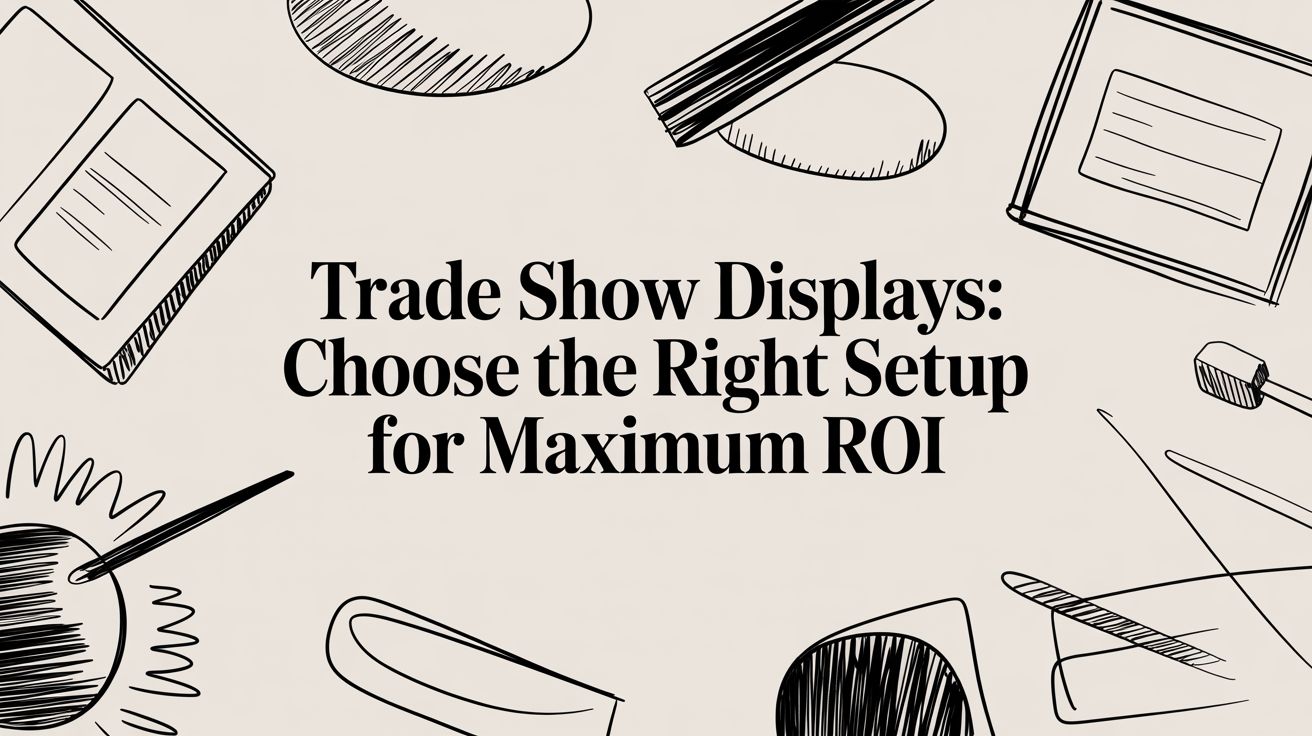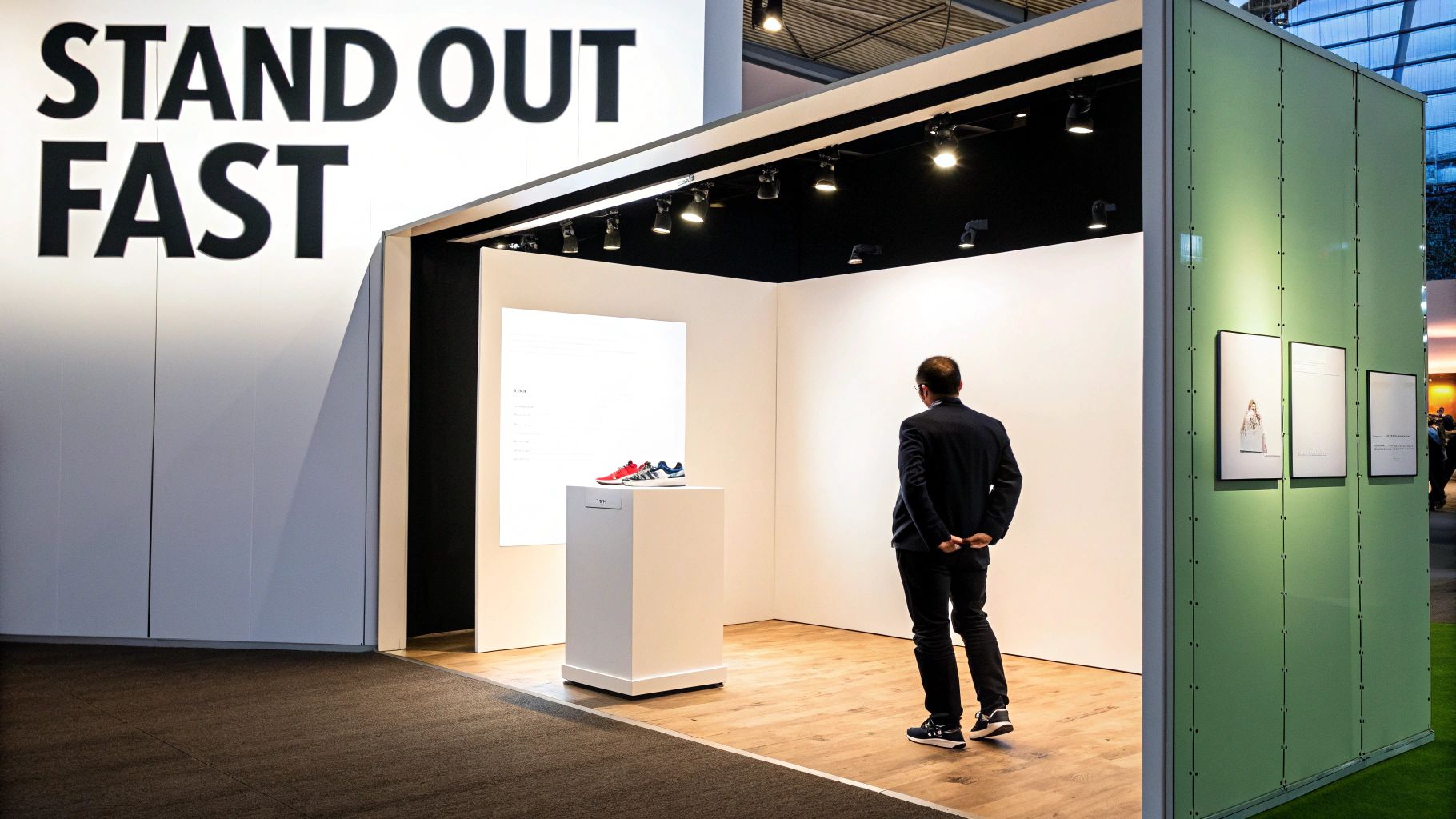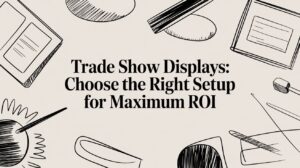
Choosing Scoreboards for Basketball A Complete Guide
A modern basketball scoreboard is so much more than a device for tracking numbers; it's the central nervous system of the entire game-day experience. It’s

Sure, the digital world gets all the hype, but when it comes to forging real connections and landing qualified leads, nothing beats a killer trade show display. These aren't just backdrops; they're your brand’s physical handshake, the one thing designed to stop people dead in their tracks and pull them in for a conversation. From a simple, sharp-looking banner stand to an immersive LED video wall, the right display becomes your best salesperson on a chaotic event floor.
Picture it: a massive convention hall, thousands of people streaming by hundreds of booths, all fighting for the same few seconds of attention. In that sea of noise, your display is the first—and maybe only—chance you get to make someone look twice. It’s not just a structure; it’s your most valuable brand ambassador, working nonstop to flag down the exact people you want to talk to.
The biggest hurdle for any exhibitor is simply cutting through the visual clutter. A boring booth with a generic sign just fades into the background, but a well-thought-out display actively reels people in. It telegraphs what you're about in an instant, tells a story without saying a word, and creates an inviting space where real business can happen. This guide is your playbook for choosing, designing, and using a display that does just that.
An effective display does more than just occupy your rented floor space—it turns that patch of carpet into a destination. It’s the difference between being a booth people walk past and one they walk to. That means nailing the elements that create a powerful first impression.
We'll walk through the big decisions that make or break a booth, including:
Your trade show display is an investment in opportunity. Its real job is to filter the crowd, grabbing the attention of qualified prospects while letting everyone else walk on by. This ensures your sales team spends their time with people who actually matter to your business.
The whole point is to draw a straight line from a well-executed display to real, measurable growth. With the US B2B trade show market hitting $15.8 billion in 2024, the stakes have never been higher. And when you consider that 48% of exhibitors say an eye-catching display is their most effective tool for attracting attendees, it’s clear a powerful booth isn't a luxury anymore—it's essential for success.
Picking the right hardware for your trade show booth is a bit like choosing a vehicle for a road trip. A sleek sports car is a thrill, but it’s completely impractical for hauling the whole family across the country. In the same way, a massive island display is total overkill for a small regional conference.
Your choice has to match the destination—your specific event goals, your budget, and the kind of brand presence you want to project. Let's walk through the most common types of displays, ditching the stale industry jargon to help you find the perfect fit. This is all about making sure you invest in a solution that works for you, not against you.
This decision tree is a great starting point. It helps you connect your primary goal—whether that's grabbing mass attention or zeroing in on qualified leads—with the right kind of display.

As the visual shows, your main objective should steer you toward a certain style of booth. It’s a simple way to cut through the noise and focus on what will actually deliver results.
To make the decision even easier, here’s a quick-reference table that breaks down the most common display types. It compares them based on the factors that matter most to exhibitors on the ground.
| Display Type | Best For | Typical Size | Portability | Avg. Cost Range |
|---|---|---|---|---|
| Banner Stands | Quick messaging, small spaces, budget-conscious exhibitors. | 2-3 ft wide | Very High | $150 – $500 |
| Pop-Up Displays | 10×10 or 10×20 booths, exhibitors needing a professional look with easy setup. | 8-20 ft wide | High | $1,500 – $5,000 |
| Modular Displays | Companies attending multiple shows with varying booth sizes; long-term investment. | 10×10 to 20×20+ | Medium | $5,000 – $25,000+ |
| Island/Peninsula | Industry leaders aiming for total immersion and brand dominance. | 20×20 or larger | Low | $25,000 – $100,000+ |
This table gives you a snapshot of your options, but let's dive into what makes each one tick.
Think of banner stands as the business cards of the event world. They’re compact, incredibly easy to transport, and perfect for delivering a quick, punchy brand message. Just like a business card, a banner stand isn't meant to tell your company's entire life story, but it makes a sharp, professional first impression and can be deployed anywhere in seconds.
These are fantastic for tiny booth spaces, as supporting elements in a larger exhibit, or for use in lobbies and breakout rooms away from the main show floor. Their biggest strengths are their affordability and dead-simple setup.
Pop-up displays are the true chameleons of the trade show floor. Their clever accordion-style frames expand to create a big, seamless graphic back wall, and they can easily adapt to different booth sizes, most commonly 10×10 or 10×20 feet. They give you a serious visual upgrade from a simple banner stand without a huge jump in cost or complexity.
Their adaptability is why they’re a favorite for companies that exhibit at multiple shows with different space allotments. The market reflects this popularity; while banner stands sell in higher volumes, higher-margin pop-up displays can generate $600,000-$900,000 for a seller from just 800-1,200 units.
A pop-up display strikes a critical balance. It’s professional enough to establish credibility and large enough to create an environment, yet it remains manageable for a small team to transport and set up without specialized labor.
This sweet spot makes it a solid investment for many growing businesses. As you think about displays, also consider how technology can give them an edge. We've seen how integrating the right LED signs for your business can turn a static pop-up into a dynamic, head-turning attraction.
Modular displays are basically the business world’s version of LEGOs. They're built from a collection of interchangeable components that you can reconfigure into countless shapes and sizes. This scalability is their superpower, allowing your display to grow and change right alongside your company's marketing goals.
You might start with a 10×20 setup for one show and then expand it into a 20×20 island exhibit for a bigger event just by adding new components. This long-term flexibility makes modular systems a seriously smart investment for businesses committed to making trade shows a core part of their strategy.
The key benefits of modular systems are pretty clear:
Finally, we have island and peninsula displays. Let's be clear: these aren't just booths; they are immersive brand destinations. An island display is open to aisles on all four sides, while a peninsula is open on three. They are, without a doubt, the largest and most commanding presence you can have on the show floor.
These setups are for established industry players who want to create a powerful, multi-sensory experience for attendees. They often feature distinct zones for product demos, private meetings, and even hospitality areas. Commanding this much space sends an unmistakable message of market leadership and confidence.

Choosing the right look for your trade show display is a massive fork in the road for your event strategy. Do you go with a static, reliable message, or a dynamic, ever-changing story? This isn't just a technical detail—it’s a decision that shapes how attendees see, interact with, and remember your brand long after they've left the show floor.
On one side, you have traditional printed graphics. These are the trusted workhorses of the industry, and for good reason. They deliver crisp, high-resolution branding that communicates a clear and powerful message. Think of a printed backdrop as a perfectly composed photograph—it’s polished, professional, and makes its point with unwavering consistency.
But on the other side, LED video walls are a whole different beast. An LED display is more like a living canvas. It can tell multiple brand stories, show off complex product demos in motion, and even switch up its messaging on the fly based on the time of day or the crowd in front of it.
The biggest difference comes down to one thing: engagement. A printed graphic commands attention with its design and clarity. An LED wall, however, grabs attention with motion, brightness, and change. That dynamic edge lets you cycle through different products, flash up customer testimonials, and rotate brand messages, basically giving you multiple displays in one.
One key term you'll hear thrown around with LED walls is pixel pitch. Don't let the jargon scare you; it’s just like the resolution on your TV. Pixel pitch is the distance from the center of one tiny LED to the center of the next, measured in millimeters.
A smaller pixel pitch number means the LEDs are packed closer together, creating a higher-resolution, more seamless image. This is a huge deal for trade show displays where attendees will be standing just a few feet from your screen.
For instance, a display with a 1.9mm pixel pitch will look sharp and crystal clear up close. A 6mm pitch display, on the other hand, is better suited for being viewed from way across the hall. Getting this right is critical to making your content look professional, not like a pixelated scoreboard from the 80s.
Both options have their own clear advantages and disadvantages. The right choice really hinges on your specific marketing goals, your budget, and the story you absolutely need to tell on that show floor. You have to look at the full picture, from the initial investment to the kind of impact you want to make on-site.
Here’s a head-to-head comparison of the core factors:
For brands with a single, focused message and a tighter budget, printed graphics are a reliable and professional way to go. They are fantastic for establishing a strong, static brand presence that looks great from the moment the show opens to the moment it closes. Their simplicity is a massive strength.
However, for exhibitors who need to demo software, show off a portfolio of work, or just stop people in their tracks with powerful video, the choice is obvious. LED displays provide a storytelling platform that static graphics simply can't touch. For those ready to dive in, getting to know the specifics of Smart LED indoor LED wall panels can offer a much deeper look into what they can do.
Ultimately, this decision is about defining your booth’s personality. Do you want it to be a beautiful, static monument to your brand, or a dynamic, living storyteller that can adapt and engage in real time? Answering that question will point you directly to the right technology for your next event.

Alright, you've got the hardware sorted. Now for the fun part—the art of attraction. A great trade show display is only half the battle; how you use it to tell your brand’s story is what really stops people in their tracks and pulls them in.
Your design needs to work fast. On a chaotic show floor, attendees make snap judgments in a blink. You have to grab their attention before they drift to the next booth.
This all comes down to the legendary “three-second rule.” You have a tiny window, maybe three seconds, to capture someone’s interest as they walk by. In that moment, your booth's main message has to answer their silent, all-important question: “What’s in it for me?” If they can’t figure it out instantly, they're gone.
To nail the three-second rule, you need a crystal-clear visual hierarchy. Think of your messaging like a pyramid. The most important, eye-catching statement sits at the very top, with supporting details layered underneath. This structure naturally guides the eye and delivers information without overwhelming them.
A powerful visual hierarchy almost always follows this simple formula:
This layered approach lets you communicate effectively at different distances, drawing people in one step at a time. It’s the perfect antidote to the all-too-common mistake of information overload—that wall-of-text booth that says everything and absolutely nothing at the same time.
Beyond your words, color and lighting are your secret weapons for setting a mood and directing focus. They work on a subconscious level to make your booth feel inviting, professional, and impossible to forget.
Color psychology is a real and potent force. Blues, for instance, often project trust and stability, which is why you see them everywhere in tech and finance. Reds create a sense of urgency and excitement, while greens tap into feelings of health, nature, and growth. Choose a color palette that not only matches your brand but also sparks the exact emotion you want attendees to feel when they see you.
Lighting is the secret weapon of great booth design. It can transform a flat, boring space into a dynamic environment, create an unforgettable ambiance, and guide every eye to your most important products or messages.
The right lighting makes your graphics pop and your products gleam. Use spotlights to highlight a new offering or your main headline. Backlighting can make your entire display glow, making you stand out from the dimly lit booths around you. The goal is to create contrast and depth, making your space look more premium and appealing than anyone else's.
Last but not least, the font you choose matters way more than you think. Your typography absolutely must be readable from a distance. That cool, intricate script might look great on a business card, but it will be a blurry, unreadable mess from 20 feet away on a crowded show floor.
Just stick to these simple rules for your fonts:
By combining a clear message hierarchy, strategic color and lighting, and readable typography, you’ll transform your display from a simple backdrop into a powerful magnet for your ideal customers.
A stunning trade show display is a powerful tool, but let's be honest—its real worth is measured by the business it brings in. To make sure your investment actually pays off, you need a smart, comprehensive budget that looks far beyond the display's price tag. It’s a lot like buying a car; the sticker price is just the starting line. The true cost includes insurance, gas, and maintenance down the road.
In the same way, the total cost of your trade show presence is a mix of many critical expenses. A well-planned budget accounts for all of it, saving you from last-minute financial headaches and setting you up to actually measure your return on investment (ROI). If you ignore these costs, a promising event can quickly become a money pit.
Your budget has to cover every single line item involved in getting your display from your warehouse to the show floor and back again. These often-overlooked costs can sneak up on you and add up fast, so planning ahead is absolutely essential.
Here are the key expenses you need to factor in:
One of the biggest financial decisions you'll face is whether to rent or buy your trade show displays. Each path has its own financial perks, depending on your company’s event calendar and long-term goals. Renting is like a test drive—it’s a fantastic option if you only exhibit once in a while or want to try out a bold, ambitious new design without a huge upfront investment.
Buying, on the other hand, is a long-term play. If your company is a regular on the trade show circuit, purchasing a durable, reusable display can dramatically lower your cost-per-show over time. This is especially true for modular systems or LED displays, which you can reconfigure or just update with new content—completely sidestepping the recurring cost of printing new graphics for every single event. To make sure your efforts are hitting the mark, exploring effective marketing budget planning strategies can help guide your investment.
At the end of the day, the goal is to generate more value than you spend. A straightforward way to track this is by calculating your Cost Per Lead (CPL). This metric gives you a clear, tangible number to see how successful your event really was.
To find your CPL, simply divide your total event cost by the number of qualified leads you generated. A lower CPL means your investment is working more efficiently to bring in new business opportunities.
This focus on ROI is more critical now than ever. The trade show industry is making a strong comeback, with exhibit space growing by 2.5% and exhibitor numbers jumping 2.8% in late 2024. This renewed spending highlights why strategic budgeting is so important for maximizing returns in what's projected to be a $2.194 trillion event market by 2028.
A durable, high-impact display directly feeds into a better ROI by pulling more qualified prospects into your booth. While a dynamic LED display might have a higher initial cost, its power to generate more leads can result in a much lower CPL over its lifespan. Understanding the complete picture is key, which is why resources that break down the factors influencing the cost of high-impact outdoor LED signs can offer a valuable perspective for your overall budget planning.
A show-stopping display is useless if it doesn't arrive on time, in one piece, and get set up without a hitch. The real work for a successful trade show begins weeks—sometimes months—before you ever step onto the show floor. It all comes down to meticulous planning and mastering the logistics. Winging it is just a recipe for last-minute stress, surprise fees, and a booth that doesn't live up to its potential.
Think of your pre-show prep as laying the foundation for a house. If it’s not solid, everything you build on top of it is at risk. Your first and most important step is to read the exhibitor manual. Seriously. This isn't just a suggestion; it's your playbook. It contains every critical deadline, rule, and service order form you'll need. Miss the deadline for ordering electricity? Get ready to pay "floor rates" that can easily double your cost.
Once you know the rules, you need a plan to get your display from your warehouse to your booth space. This isn't as simple as just shipping a box. You have two major hurdles: shipping to the venue and drayage once it's there.
Drayage, also known as material handling, is the fee the show's official contractor charges to move your freight from the loading dock to your booth. This is often the most shocking hidden cost for new exhibitors, and it's usually calculated by weight. To keep these costs from spiraling, you need to pack smart. Use lightweight materials, consolidate your shipments, and be efficient. For complex moves, you might even need specialized trade show mover services to navigate the tight schedules and regulations.
When setup day finally arrives, a clear, step-by-step plan is your best friend. Don't try to rely on memory, especially when your team is running on airport coffee and adrenaline. A solid strategy is the difference between a smooth, efficient build and a chaotic scramble.
Before you even book your flight, prepare and pack these essentials:
Having a dedicated emergency kit seems minor until you're on the floor and a critical connector breaks or a graphic panel gets scuffed during shipping. Preparation prevents panic and allows you to solve problems instantly without losing valuable setup time.
Finally, think about teardown before you even set up. Protecting your investment for the long haul starts with proper care. Clean all surfaces before you dismantle your display. Use high-quality packing materials and custom-fitted cases to prevent the kind of transit damage that can cheapen the look of your booth. A display that's treated well will continue to represent your brand beautifully, show after show, maximizing its lifespan and your ROI.
Jumping into the world of trade shows for the first time? It's natural to have a few questions. Getting the right answers can be the difference between a killer event and a series of headaches you didn't see coming. Let's clear up some of the most common things people ask, so you can make smarter decisions for your next exhibition.
This is easily one of the most frequent questions we get, and the answer is almost always the same: start way earlier than you think you need to. For a custom trade show display, give yourself a window of three to six months before the event. I know it sounds like a lot, but rushing this process is a guaranteed recipe for mistakes, compromises, and painful rush fees.
That timeline isn't just a random number; it's built around a few critical stages that you simply can't skip.
Giving yourself this much runway takes all the stress out of the equation and ensures every detail is exactly right.
If there's one pitfall I see exhibitors fall into time and time again, it's information overload. It’s a tempting trap—you're proud of your company and want to shout everything from your founding story to every last product feature from the rooftops. But here's the hard truth: when you try to say everything, a busy attendee hears nothing at all.
Your display's back wall should work like a billboard, not a brochure. Its one job is to hook people walking by with a single, powerful message that makes them curious. A booth buried under paragraphs of text, endless bullet points, and a collage of logos just becomes visual noise that our brains are trained to tune out. The key is to simplify.
Focus your entire design around a single core message. Support it with clean, bold graphics and a clear, simple call to action. This disciplined approach is what cuts through the clutter and invites people in for a deeper conversation.
Fight the urge to add "just one more thing." When it comes to booth design, less is absolutely more. A clean, confident display screams professionalism and makes it easy for someone to "get" what you're about in three seconds flat.
This is a fantastic question because the answer has a huge impact on your long-term budget and marketing flexibility. Whether you can swap out your graphics comes down to the kind of system you have. The good news is, most modern displays are built for this very purpose.
For instance, modular and fabric displays are champs when it comes to easy graphic swaps. Many fabric graphics use a silicone edge that just tucks into a channel on the frame. You can literally change out a massive back wall graphic in a few minutes. This makes it incredibly cost-effective to refresh your brand or tailor your message for different shows and audiences.
But when you want the ultimate in flexibility, nothing comes close to an LED video wall. Instead of dealing with ordering, printing, and shipping new physical graphics, you just update your content with a few clicks. This means you can change promotions on the fly, showcase different products throughout the day, or run a whole library of videos—all with zero extra production or shipping costs. That kind of adaptability makes an LED display a powerful, future-proof investment for any serious exhibitor.
Ready to create a trade show display that stops attendees in their tracks? The expert team at Smart LED Inc. can help you design a dynamic LED video wall that makes your brand unforgettable. Explore our high-impact solutions and get a quote today.
Learn more and get started at https://smartledinc.com

A modern basketball scoreboard is so much more than a device for tracking numbers; it's the central nervous system of the entire game-day experience. It’s

Sure, the digital world gets all the hype, but when it comes to forging real connections and landing qualified leads, nothing beats a killer trade

A digital message board is more than just a screen; it's a living, breathing poster. Instead of static ink on paper, it uses brilliant screen
"*" indicates required fields